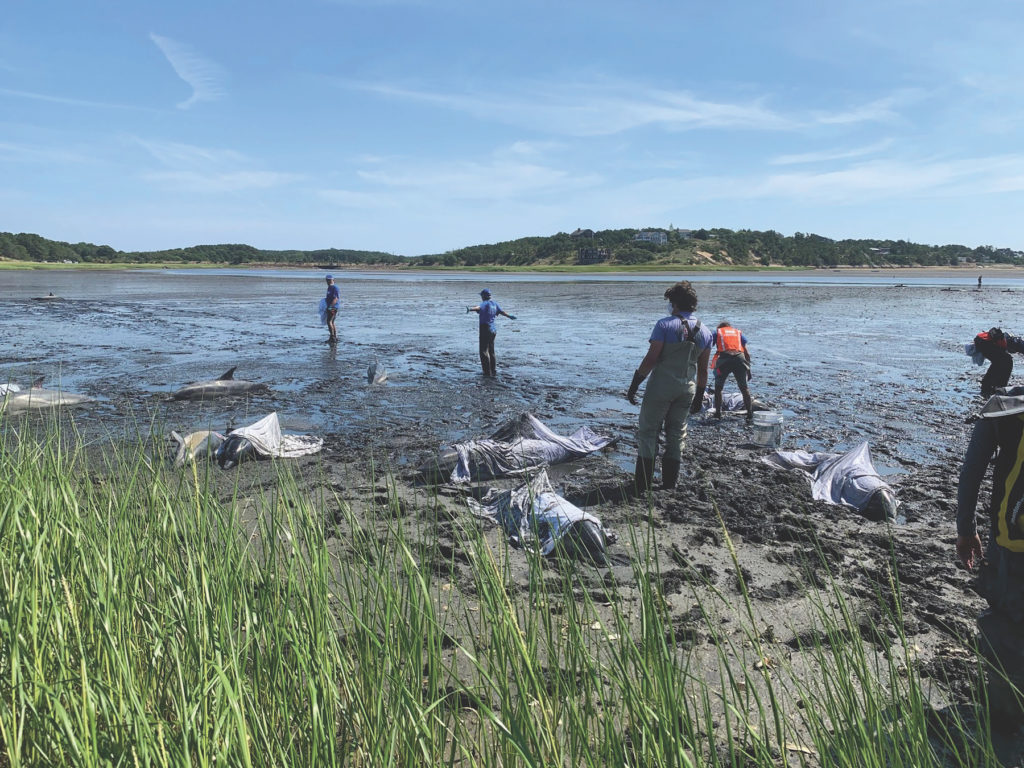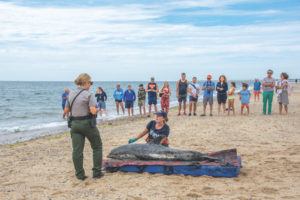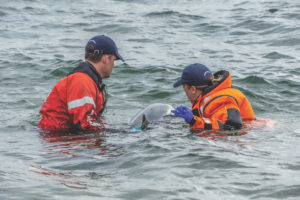PROVINCETOWN — Cape Cod has always had more dolphin strandings than anywhere else in the world. But 2024 was the worst year for strandings ever recorded here, and scientists have been trying to figure out why. Now they think they’ve found the reason: a “cold pulse” — a rush of colder, fresher water from the north, shocking the climate change-warmed Gulf of Maine.
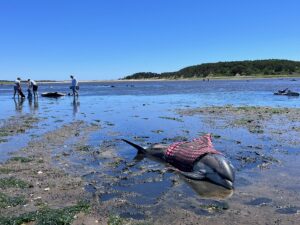
The Cape is one of the dolphins’ prime feeding grounds, and its shape, shallow waters, fast currents, and big tidal fluctuations are some of the reasons strandings are common here. But it’s been hard to account for last year’s dramatic increase. According to the International Fund for Animal Welfare (IFAW), whose marine mammal rescue team is based in Yarmouth Port, there were a total of 376 dolphin strandings in 2024 — more than six times the annual average of 57. That year also included the largest mass stranding in U.S. history, when 146 dolphins stranded in Wellfleet Harbor on June 28.
Glen Gawarkiewicz, associate scientist of physical oceanography at Woods Hole Oceanographic Institution, said the cold pulse threw off the ocean ecosystem and likely disrupted the dolphins’ offshore food sources, forcing them to seek food in shallower water, which put them at greater risk of stranding.
Scientists are still studying the cold pulse to understand its precise cause, Gawarkiewicz said. But they know that, with climate change, “the system is getting much more impulsive now. We can get these big anomalies.”
Oceanographers saw a significant drop in ocean temperatures across the Atlantic starting in August 2023, and it got more extreme starting in April 2024, Gawarkiewicz said. The cold water appears to have flowed from the Grand Banks and the Labrador Sea, he said, and caused temperatures to drop by 5 to 9 degrees Fahrenheit, from the coast to the edge of the Gulf Stream all the way down to the Carolinas. “I hadn’t seen anything like that before in the 40 years I’ve been going out to sea,” he said.
Both Warmer and Colder
According to Nick Record, senior research scientist at the Bigelow Laboratory for Ocean Sciences in Boothbay, Maine, pulses of cold Labrador water have always been a regular occurrence in the Gulf of Maine, but climate change has made them more extreme. The water now shifts from warm to cold more quickly. And because the Gulf of Maine is so much warmer now, the cold water is more of a shock. That cold water, he told the Independent in an email, “would have been normal temperature 20 years ago or so.”
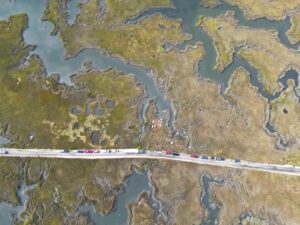
The Gulf of Maine has been getting warmer since 2010, so when the cold pulse arrived, all the creatures who were accustomed to warm water were unable to adapt to the rapidly dropping temperatures. “The whole ecosystem was in a chaotic state,” Gawarkiewicz said, and many species left to find more comfortable habitats.
Warm-water species, such as black sea bass, disappeared; and squid, which usually arrive in May, were nowhere to be found. “For a number of dolphin species, squid are an important food,” Gawarkiewicz said. This left the predators with no food and forced them to forage closer to shore. “The fact that everything lower in the food chain was so disrupted — I had to think that had a dire impact on dolphins,” Gawarkiewicz said.
Lesley Thorne, an associate professor of marine and atmospheric sciences at the State University of New York at Stony Brook, agreed with Gawarkiewicz. “Over the long term, you’ve got some of these warmer-water species moving further north,” she said. “But at the same time, you’ve got this anomalous year oceanographically, which is really altering foraging conditions in parts of the Northeast.” This combination, she said, may have been the cause of the mass dolphin strandings.
Already a ‘Hot Spot’
The cold pulse adds a new challenge in a place that is already a stranding hot spot, according to Scott Landry, director of the marine mammal entanglement response program at the Center for Coastal Studies.

Cape Cod’s extreme tides are one reason: it’s easy for dolphins that are searching for fish in shallow water here to get stuck when the tide goes out. “The fish head to the beach, and therefore maybe the dolphins also accidentally head to the beach,” Landry said.
“On Cape Cod, the currents are fierce,” said Landry, and that can make strandings worse. Following the curved shape of the Cape, the currents flow counterclockwise around the Bay, often bringing tired, hurt, or sick dolphins into Wellfleet Harbor. Then, because the harbor is shallow, the dolphins may get stressed and panic, causing them to get more stuck.
Overall, Cape Cod’s hook shape also acts as a trap, Landry said, making it difficult for dolphins to navigate out.
According to Landry, another reason that dolphins strand a lot is that they are very social animals. Dolphins live in family groups called pods that usually stay together for life. Landry said that if one dolphin in a pod is ill or confused and goes in to shore, the rest of the pod may follow and strand as well.
Changes in the dolphins’ food sources are another problem. As climate change has made Cape Cod’s waters generally warmer, some shallow-water fish from the south that were once rare here have become more common, Landry said. This change forces dolphins to choose between the risk of being stranded and the risk of starvation.
Dani Stone, a veterinary technician with IFAW, agreed, adding that during last year’s strandings, “We know that there were a lot of bait fish in the water close to shore.”
Scientists do not think wind turbine development is a cause of any whale or dolphin strandings. Landry said that he has done surveys within wind energy development areas south of Martha’s Vineyard and has never noticed a whale or dolphin behaving abnormally in those zones.
On High Alert
Strandings put dolphins in a very vulnerable situation. On land, “they have a lot of gravity pushing down on organs that would normally be buoyant,” which can be lethal, Stone said.
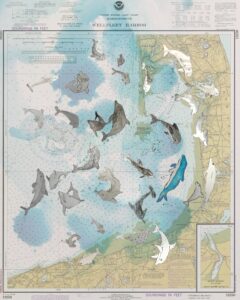
Nora Harrington, Bettina Markowski, Deborah Markowski, Shania Marriott, Steven Meserve, Aiden Porter, Daisy Rios, Lola Schiffer-Kehou, Brandon Stefani, Brianna Walker, and Kimora Wright)
If you see a dolphin on the beach, Stone said, do not feed it or touch it. Instead, stand by the dolphin, call IFAW, and report it. When IFAW volunteers arrive, they make sure that the animal is healthy and check for entanglement in fishing gear.
IFAW usually releases the animals at Herring Cove Beach in Provincetown because there the water is very deep close to shore, ensuring that the dolphins can swim freely. Dolphins are moved by trolley to vans for transport. And IFAW makes sure dolphins are in good condition before being released back into the ocean.
It is unclear whether dolphin strandings around Cape Cod will keep getting worse. “If there’s a lot of food here next year, then yes, the strandings, I bet, will be worse,” Landry said.
“We’re all hoping that it was just an anomaly,” Stone said of the surge in strandings last year. “But we are all mentally prepared for it to be just as bad. We’re all on high alert here.”
Staff reporter William von Herff worked with five Provincetown IB Schools students to research and write this story.
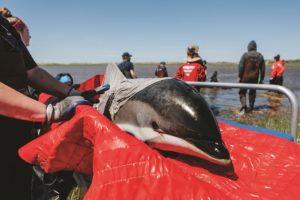
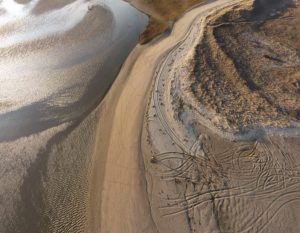 Common dolphins, like other pelagic marine mammals, are accustomed to the open sea. “They don’t understand tides,” said Guerra, so when their food source swims close to the shore, stranding becomes a risk.
Common dolphins, like other pelagic marine mammals, are accustomed to the open sea. “They don’t understand tides,” said Guerra, so when their food source swims close to the shore, stranding becomes a risk.